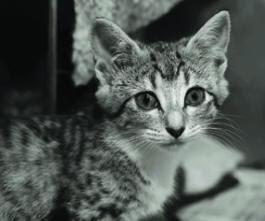 |
| The caption on the website reads: 'She Deserves To Live |
 |
| Trapped feral for spay or neuter |
 |
| Cat with no home, no one to look after him but himself and he's punished for it |
 |
| Feral Dogs |
 |
| Australian Dingo |
 | |||
| Coyote taking refuge in empty bus, as much a victim as the feral cats |
 | ||
| More victims of human inhumanity |
These are the predators of the feral cats that we humans have created in colonies round the globe over the past century.
No animal deserves this treatment from a humane, civilized society and yet...
In1916 a report was done for the Massachusetts State Board of Agriculture entitled The Domestic Cat: Bird Killer, Mouser and Destroyer of Wildlife. In this report, noted Ornithologist Edward Howe Forbush stated in the preface:
"Questions regarding the value or in-utility of the domestic cat and problems connected with limiting its more or less unwelcome outdoor activities are causing much dissension. The discussion has reached an acute stage. Medical men, game protectors and bird lovers call on legislators to enact restrictive laws. Then ardent cat lovers rouse themselves for combat. In the excitement of partisanship many loose and ill-considered statements are made."
This report actually cited Extinct Birds, a book published in 1905 by zoologist Walter Rothschild who stated, "man and his satellites, cats, rats, dogs and pigs are the worst and in fact the only important agents of destruction of the native avifaunas wherever they go."
 |
| Stephens Island Wren, extinct bird species |
Rothschild went on to give several examples of cats in general causing the extermination of some bird species on islands.
Apparently the man gave equally no thought to how these feral and domesticated cats got there in the first place and that it took some brilliant 'human' to come up with the idiotic idea of populating already populated islands with rabbits and cats in the first place! Really, some people ought to try 'thinking' before they talk out loud!!
Even today there are farmers and gamekeepers that see feral cats as absolute vermin to be exterminated at all cost. Because the feral cat populations catch and eat ground nesting birds like pheasants and partridge that are protected, for no better reason than for people to kill them in flight when they go on their hypocritical bird hunts ~ not unlike the excuses they give for local fox hunting. To protect their birds some gamekeepers have resorted to setting traps and shooting any feral cats they find, on sight, as part of their ongoing, so-called pest control campaigns. Does this sound like a charmed life of freedom to you?
Please, think twice before dumping your unwanted cats on some farm or dairy or by the side of the road, your actions have direct consequences for these animals. Do the more humane thing and at least take the unwanted animal to a shelter or SPCA. Lets not forget that these animals actually 'trust' us to have their best interests at heart. No animal, pet or otherwise, is expendable. If they do become expendable in our world view, which animal is next? Will it be an animal or perhaps an unwanted child. Ask yourself.
 |
| Help me, don't hurt me ~ the choice is yours, not mine |



No comments:
Post a Comment
Hi and thanks for visiting my blog. I am very grateful for your comment and please leave a link.